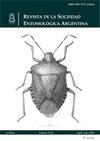Food supply in honeybee colonies improved kiwifruit (Actinidia deliciosa Liang & Ferguson) (Actinidiaceae: Theales) pollination services
IF 0.5
4区 农林科学
Q4 ENTOMOLOGY
引用次数: 1
Abstract
The current agriculture model determines a decrease in semi-natural habitats leading to poor nutrition for honeybee colonies, which usually need to be food supplemented. Honeybees are used to transfer pollen between male and female kiwifruit (Actinidia deliciosa Liang & Ferguson) plants, increasing fruit quality and crop yield. Our main goal was to determine the effect of stimulating Apis mellifera L. colonies with standard food supplies on the collection of kiwifruit pollen. However, honey bees can also forage other flowering species in the crop site's surrounding areas. We selected kiwifruit as a model to analyze the effects of food supply on pollen collection of the target crop. The following experimental treatments (n = 5 hives each were conducted in a kiwifruit orchard in Mar del Plata, Argentina: Group J/A: supplied with sugar syrup (2:1 + liquid protein supplements (“Apipromotor ®”; Group J/P: supplied with sugar syrup (2:1 + solid protein supplements (“patty”; Group J: supplied with sugar syrup (2:1; Group C: control, not supplied. Colonies supplied with J, J/P and J/A collected more kiwifruit pollen than the other two treatments, even under other flowering species in areas nearby. Although honeybees collected most pollen from other plant species of semi-natural habitats, J/P, J, and J/A treatments can significantly improve the honeybees' kiwifruit pollination service.猕猴桃(Actinidia deliciosa Liang & Ferguson)(猕猴桃科:Theales)授粉服务在蜜蜂群体中的食物供应
目前的农业模式决定了半自然栖息地的减少,导致蜂群营养不良,通常需要食物补充。蜜蜂被用来在雄性和雌性猕猴桃(Actinidia deliciosa Liang & Ferguson)植物之间传递花粉,提高果实质量和作物产量。我们的主要目的是确定用标准食物刺激蜜蜂菌落对猕猴桃花粉收集的影响。然而,蜜蜂也可以在作物所在地周围的其他开花物种中觅食。我们选择猕猴桃作为模型,分析食物供应对目标作物花粉收集的影响。在阿根廷马德普拉塔的一个猕猴桃果园中进行了以下试验处理(n = 5个蜂巢):J/ a组:提供糖浆(2:1)+液体蛋白质补充剂(“Apipromotor®”);J/P组:提供糖浆(2:1)+固体蛋白质补充剂(“肉饼”);J组:配以糖浆(2:1);C组:对照组,不提供。J、J/P和J/A处理比其他两种处理收集到的猕猴桃花粉更多,即使在附近其他开花物种下也是如此。虽然半自然生境中蜜蜂主要从其他植物采集花粉,但J/P、J和J/A处理能显著提高蜜蜂对猕猴桃的授粉服务。
本文章由计算机程序翻译,如有差异,请以英文原文为准。
求助全文
约1分钟内获得全文
求助全文
来源期刊

Revista De La Sociedad Entomologica Argentina
Agricultural and Biological Sciences-Insect Science
CiteScore
0.80
自引率
20.00%
发文量
31
审稿时长
20 weeks
 求助内容:
求助内容: 应助结果提醒方式:
应助结果提醒方式:


